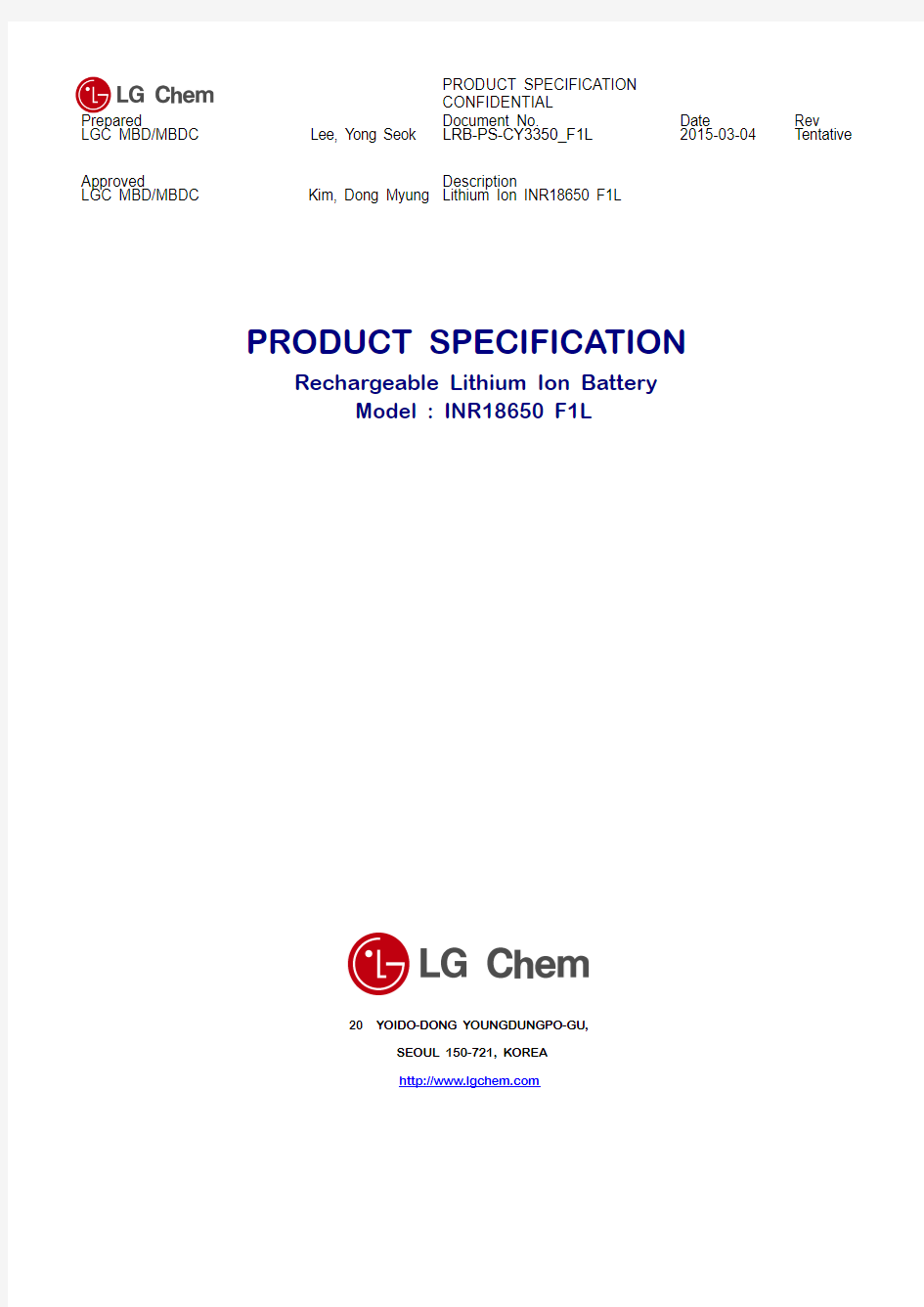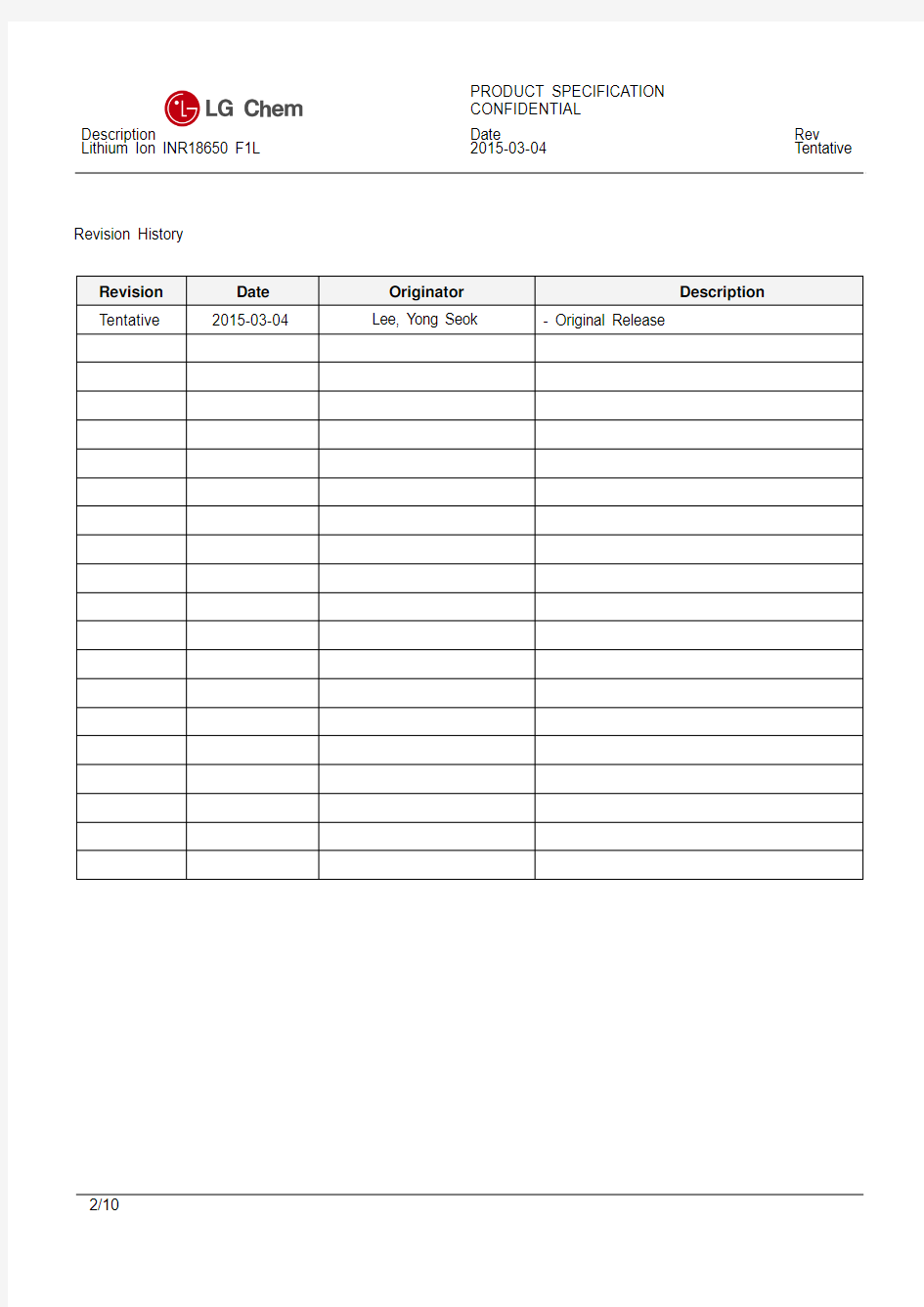150304_PS_LGC_INR18650_F1L_v1


CONFIDENTIAL
Prepared Document No. Date Rev LGC MBD/MBDC Lee, Yong Seok LRB-PS-CY3350_F1L 2015-03-04 Tentative
Approved Description
LGC MBD/MBDC Kim, Dong Myung Lithium Ion INR18650 F1L
PRODUCT SPECIFICATION
Rechargeable Lithium Ion Battery
Model : INR18650 F1L
20 YOIDO-DONG YOUNGDUNGPO-GU,
SEOUL 150-721, KOREA
https://www.360docs.net/doc/e84749724.html,
Lithium Ion INR18650 F1L 2015-03-04 Tentative Revision History
Lithium Ion INR18650 F1L 2015-03-04 Tentative
Contents (3)
1. General Information (4)
1.1 Scope
1.2 Product Classification
1.3 Model Name
2. Nominal Specification (4)
2.1 Capacity
2.2 Nominal Voltage
2.3 Standard Charge
2.4 Max. Charge Voltage
2.5 Max. Charge Current
2.6 Standard Discharge
2.7 Max. Discharge Current
2.8 Weight
2.9 Operating Temperature
2.10 Storage Temperature (for shipping state)
3. Appearance and Dimension (5)
3.1 Appearance
3.2 Dimension
4. Performance Specification (5)
4.1 Standard Test Condition
4.2 Electrical Specification
4.3 Environmental Specification
4.4 Mechanical Specification
4.5 Safety Specification
5. Caution (8)
5.1 Cautions for Use and Handling
5.2 Prohibitions
5.3 Caution for the battery and the pack
6. Exclusion of Liability (10)
Lithium Ion INR18650 F1L 2015-03-04 Tentative 1. General Information
1.1 Scope
This product specification defines the requirements of the rechargeable lithium ion battery to be supplied
to the powerbank customers by LG Chem.
1.2 Product classification : Cylindrical rechargeable lithium ion battery
1.3 Model name : INR18650F1L
2. Nominal Specification
Lithium Ion INR18650 F1L 2015-03-04 Tentative 3. Appearance and Dimension
3.1 Appearance
There shall be no such defects as deep scratch, crack, rust, discoloration or leakage, which may
adversely affect the commercial value of the cell.
3.2 Dimension
Diameter : 18.29 ± 0.11 mm
Diameter is defined as the largest data value measured on the head area (A) of a cylindrical cell
Height : ≤65.15 mm
4. Performance Specification
4.1 Standard test condition
4.1.1 Standard Charge
Unless otherwise specified, “Standard Charge” shall consist of charging at constant current of 0.3C. The cell shall then be charged at constant voltage of 4.20V while tapering the charge current. Charging shall be terminated when the charging current has tapered to 50mA. For test purposes, charging shall be
performed at 24oC ± 2oC.
4.1.2 Standard Discharge
“Standard Discharge” shall consist of discharging at a constant current of 0.2C to 2.5V. Discharging is
to be performed at 24oC ± 2oC unless otherwise noted (such as capacity versus temperature).
Lithium Ion INR18650 F1L 2015-03-04 Tentative
4.1.3 Charge / discharge condition
Cells shall be charged at constant current of 0.3C to 4.20V with end current of 50mA. Cells shall be discharged at constant current of 0.5C to 2.50V. Cells are to rest 10 minutes after charge and 20 minutes after discharge.
4.2 Electrical Specification
4.3 Environmental specification.
* Remaining Capacity : After storage, cells shall be discharged with Std. condition(4.1.2) to measure the remaining capacity.
** Recovery Capacity: After storage, cells shall be discharged with Std. condition (4.1.2), and then cells shall be charged with std. charge condition(4.1.1), and then discharged with Std. condition(4.1.2). This charge / discharge cycle shall be repeated three times to measure the recovery capacity.
Lithium Ion INR18650 F1L 2015-03-04 Tentative
4.4 Mechanical Specification
4.5 Safety Specification
Lithium Ion INR18650 F1L 2015-03-04 Tentative
5. Caution
Warning for using the lithium ion rechargeable battery. Mishandling of the battery may cause heat, fire and deterioration in performance. Be sure to observe the following.
5.1 Cautions for Use and Handling
When using the application equipped with the battery, refer to the user’s manual before usage.
Please read the specific charger manual before charging.
Charge time should not be longer than specified in the manual.
When the cell is not charged after long exposure to the charger, discontinue charging.
Battery must be charged at operating temperature range 0 ~ 45oC.
Battery must be discharged at operating temperature range -20 ~ 50oC (skin temperature 60oC).
Please check the positive(+) and negative(-) direction before packing.
When a lead plate or wire is connected to the cell for packing, check out insulation not to short-circuit.
Battery must be stored separately.
Battery must be stored in a dry area with low temperature for long-term storage.
Do not place the battery in direct sunlight or heat.
Do not use the battery in high static energy environment where the protection device can be damaged.
When rust or smell is detected on first use, please return the product to the seller immediately.
The battery must be away from children or pets.
When cell life span shortens after long usage, please exchange to new cells.
Lithium Ion INR18650 F1L 2015-03-04 Tentative
5.2 Prohibitions
Do not use different charger. Do not use cigarette jacks (in cars) for charging.
Do not charge with constant current more than maximum charge current.
Do not disassemble or reconstruct the battery.
Do not throw or cause impact.
Do not pierce a hole in the battery with sharp things. (such as nail, knife, pencil, drill)
Do not use with other batteries or cells.
Do not solder on battery directly.
Do not press the battery with overload in manufacturing process, especially ultrasonic welding.
Do not use old and new cells together for packing.
Do not expose the battery to high heat. (such as fire)
Do not put the battery into a microwave or high pressure container.
Do not use the battery reversed.
Do not connect positive(+) and negative(-) with conductive materials (such as metal, wire)
Do not allow the battery to be immerged in or wetted with water or sea-water.
5.3 Caution for the battery and the pack
Pack shall meet under condition to maintain battery safety and last long performance of the lithium rechargeable cells.
5.3.1 Installing the battery into the pack
-. The cell should be inspected visually before battery assembly into the pack.
-. Damaged cell should not be used. (damaged surface, can-distortion, electrolyte-smell)
-. Different Lot Number cells should not be packaged into the same pack.
-. Different types of cells, or same types but different cell maker’s should not be used together.
5.3.2 Design of battery pack
-. The battery pack should not be connected easily to any charger other than the dedicated charger.
-. The battery pack has function not to cause external short cut easily.
-. The design of battery pack and its structure should be reviewed physically,
mechanically and electrically not to cause cell imbalance.
-. The battery pack for multiple cells should be designed to monitor the voltage of each bank.
5.3.3 Charge
-. Charging method is Constant Current-Constant Voltage (CC/CV).
-. Charging should be operating under maximum charge voltage and current which is specified in the product
Lithium Ion INR18650 F1L 2015-03-04 Tentative
specification. (Article. 2.4, 2.5)
-. The battery should be charged under operating temperature specified in the product specification. (Article. 2.9) 5.3.4 Discharge
-. Discharging method is Constant Current (CC).
(In case of using the battery for mobile equipment, discharging mode could be Constant Power.)
-. Discharging should be operating under maximum discharge current which is specified in the product specification. (Article. 2.7)
-. Discharging should be done by cut off voltage which is specified in the product specification. (Article. 2.6)
-. The battery should be discharged under operating temperature specified in the product specification.
(Article. 2.9)
5.3.5 Protection Circuit
-. The protection circuit should be installed in the battery pack, charger.
-. Charger or pack should have voltage sensing system to control over charge or discharge in order to maintain the battery’s normal operating mode and protect cell imbalance.
-. Charger or pack should have warning system for over temperature, over voltage and over current.
6. Exclusion of Liability
The warranty shall not cover defects caused by normal wear and tear, inadequate maintenance, handling, storager faulty repair, modification to the battery or pack by a third party other than LGC or LGC’s agent approved by LGC, Failure to observe the product specification provided herein or improper use of installation, including but not limited to, the following:
-. Damage during transport or storage
-. Incorrect installation of battery into pack or maintenance
-. Use of battery or pack in inappropriate environment
-. Improper, inadequate, or incorrect charge, discharge or production circuit other than stipulated herein
-. Incorrect use or inappropriate use
-. Insufficient ventilation
-. Ignoring applicable safety warnings and instructions
-. Altering of attempted repairs by unauthorized personnel
-. In case of force majeure (Ex. Lightening, Storm, Flood, fire, Earthquake, Etc)
There are no warranties – Implied or express – Other than those stipulated herein. LG chem. shall not be liable for any consequential or indirect damages arising of in connection with the product specification, battery or pack.
